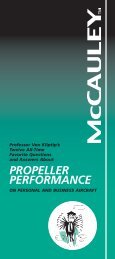commandments of propeller care - McCauley Propeller Systems
commandments of propeller care - McCauley Propeller Systems
commandments of propeller care - McCauley Propeller Systems
You also want an ePaper? Increase the reach of your titles
YUMPU automatically turns print PDFs into web optimized ePapers that Google loves.
Ground Adjustment…blade angle<br />
can be adjusted on the ground but cannot be<br />
altered in flight. Once fixed, this prop operates<br />
like a fixed pitch <strong>propeller</strong>. Blade angle can be<br />
set low for short fields and/or high terrain or for<br />
better load carrying capability; it is set at a<br />
higher angle for long runways, low terrain, or<br />
light loads when a better cruising speed is<br />
desired.<br />
Two Position…blade angle may be<br />
adjusted during operation to either low angle<br />
or a high angle setting. Low angle is used for<br />
take<strong>of</strong>f and climb, then a shift is made to high<br />
angle for cruise.<br />
Controllable Pitch…blades may be<br />
altered infinitely to any desired angle during<br />
flight, starting with a low blade angle and then<br />
gradually increasing the angle during take<strong>of</strong>f,<br />
climb, leveling out, and cruise.<br />
Automatic Pitch…blade angle change<br />
occurs automatically as a result <strong>of</strong> aerodynamic<br />
forces acting on the blades, and the pilot has no<br />
control over the changes.<br />
*Constant Speed…a governor is used<br />
in conjunction with the <strong>propeller</strong> to<br />
automatically provide constant RPM as the pilot<br />
selects the proper setting. Blade angle is<br />
changed automatically and will increase or<br />
decrease if RPM setting is decreased or<br />
increased or if power is increased or decreased.<br />
With fixed RPM and power setting, the blade<br />
angle changes automatically as airspeed<br />
increases or decreases.<br />
*Full Feathering…blades can be<br />
rotated to a high positive angle to stop rotation<br />
(windmilling). This feature is common on multiengine<br />
aircraft, because it allows an engine to<br />
be shut down and the prop stopped to reduce<br />
drag and asymmetric control forces.<br />
Beta Control…normally used for ground<br />
operation, most <strong>of</strong>ten in taxiing, where thrust is<br />
manually controlled by adjusting blade angle<br />
with the power lever.<br />
*Reversing…blades can be rotated to a<br />
“negative” blade angle where they will provide<br />
a rearward thrust to slow down, stop or move<br />
the aircraft backward. This capability is normally<br />
provided for turbine installations.<br />
*Types starred are available in various models.<br />
11



